The honey-hued Cotswolds villages and green rolling hills are renowned for their pastoral perfection, here we explore some of the most picturesque
Words: Keith Drew
North Cotswolds Villages
Picture the quintessential English village. Chances are you’re thinking of a hamlet of honeycomb coloured cottages, all thatched roofs and rose gardens. There’ll be a cobbled street, with a tinkling river running alongside, and a creaking pub with an open fire, where you can warm yourself after a bracing walk through the green hills on the horizon. Chances are you’re thinking of the North Cotswolds villages.
The Cotswold Hills stretch for nearly 800 square miles across the heart of England, but it is the chocolate-box charm of its northern Cotswolds villages that draws visitors from all over the world. Trying to pick the prettiest is a lifelong challenge for some, but the villages are so clustered together in this bucolic corner of the country that you don’t have to settle on just one.
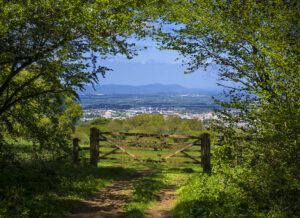
Start your journey in the so-called Jewel of the Cotswolds villages: Chipping Campden. This historically important trading centre – Chipping comes from the Old English word ceping, which means market – grew rich on wool, with merchants travelling from continental Europe to buy fleece here.
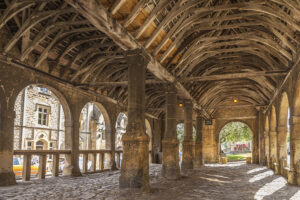
The Woolstaplers’ Hall, on the High Street, dates from 1340. Other sublime buildings along this road are the Market Hall, which still provides shelter for traders today, and 14th-century Grevel’s House, the oldest in Chipping Campden.
The town has long been linked to the Arts and Crafts Movement – the Guild of Handicraft moved here in 1902 – and there are some lovely little boutiques selling beautiful pieces of craftwork. The connection continues beyond Campden’s borders at Hidcote, 4 miles to the north, whose Arts and Crafts-inspired garden of ‘outdoor rooms’ is one of the finest in Britain. If you’re visiting Chipping Campden in June, make time in your itinerary for the Cotswold Olimpick Games, which has been going strong since 1612; it’s the home of the World Shin-Kicking Championships, among other equally eccentric only-in-England sporting events.
The leafy Cotswold Way, one of the best multi-day walking trails in England, starts in Chipping Campden and heads west through wooded hills to Broadway, on the Cotswolds’ western edge. Golden houses and horse chestnut trees line the long, wide High Street, a ‘broad way’ that was once part of the stage-coach route from Worcester to London.
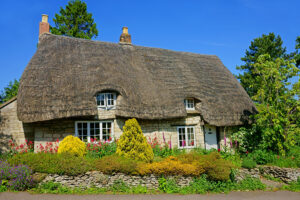
The village is one of the most rewarding places in the North Cotswolds for shopping, especially if you’re in the market for an antique or a piece of art – the High Street is lined with boutiques specializing in both. In the 1880s, the village was home to the Broadway Colony, a group of American artists that included Francis Davis Millet and John Singer Sargent, who painted his masterpiece Carnation, Lily, Lily, Rose while staying here.
The tradition survives in a number of excellent art galleries in and around the High Street. Visible from the village, just a short uphill walk away, the 18th-century Broadway Tower has far-reaching views across 16 counties on a clear day. Continuing south from Broadway, the road forks and you’ve a choice of two picture-perfect villages at the end of either. Take the right fork and, still roughly following the route of the Cotswold Way, head first to Stanton, just over two miles away.
Tiny, timeless Stanton has all the trappings of an idyllic Cotswold village, although everything here seems to be that bit more harmonious: the houses are all honeyed, clad in ivy or dripping with wisteria, and decorated with the mullioned windows, steep gables and thatched roofs that are so redolent of the region. There are no shops or tearooms, just a hilltop pub that serves local ales to residents and the occasional weary walker passing through.
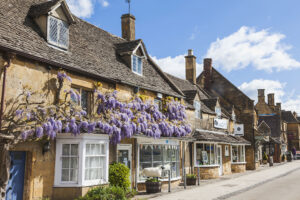
Backtracking to Broadway and picking up that other road leads shortly south again to Snowshill. The village has its own stately parish church and is home to the spectacular Cotswold Lavender Farm, a riot of purple in the summer months. Most people come here, however, for 16th-century Snowshill Manor. Bought in 1919 by the eccentric architect Charles Paget Wade, it was used as a historic setting for his extraordinary collection of curios (22,000 pieces and counting), and its rooms are a treasure trove of unusual objects: musical instruments, bicycles, Balinese masks and samurai armour. The manor is surrounded by its own Arts and Crafts garden.
Heading on south from Snowshill, it’s around 9 miles to Stow-on-the-Wold, where several roads meet at an impressive market square, lined with antiques shops, cosy pubs and quaint tearooms, all built in the mellow local stone. Look out for the medieval market stocks at one end and the ancient market cross at the other. Further south are the intriguingly named Slaughters, regarded by many as the pick of Cotswold villages. You wouldn’t know it from the pristine twin hamlets that are here today, but the Slaughters developed at a couple of boggy crossing points on the River Eye – hence the name, which derives from slothre, the Old English word for ‘muddy place’.
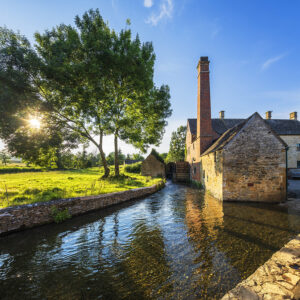
Start in Lower Slaughter, with a browse round the Old Mill’s museum and mill shop, before meandering alongside the tinkling stream that connects it with Upper Slaughter, regarded by many as the best short walk in the Cotswolds. No building has been allowed in either village since the early 1900s, giving the limestone cottages and Elizabethan manor houses here a timeless air.
This is an extract, read the full version in the January/February issue of BRITAIN Magazine available to buy here.
Read more:

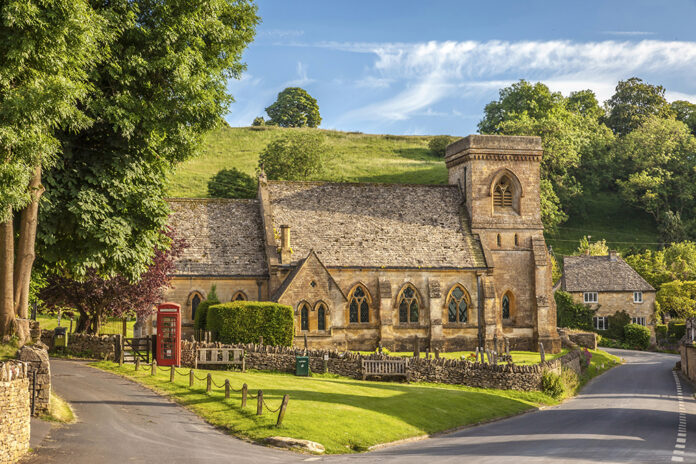




 © 2024
© 2024